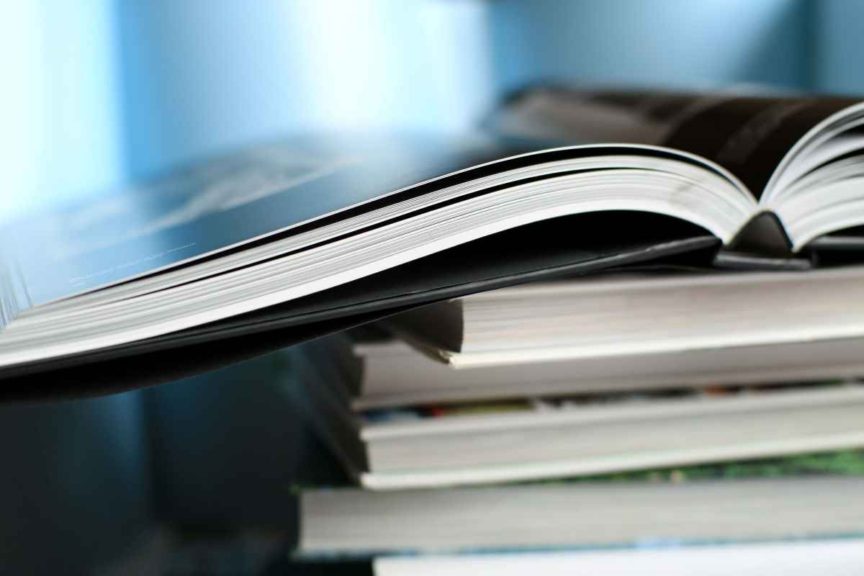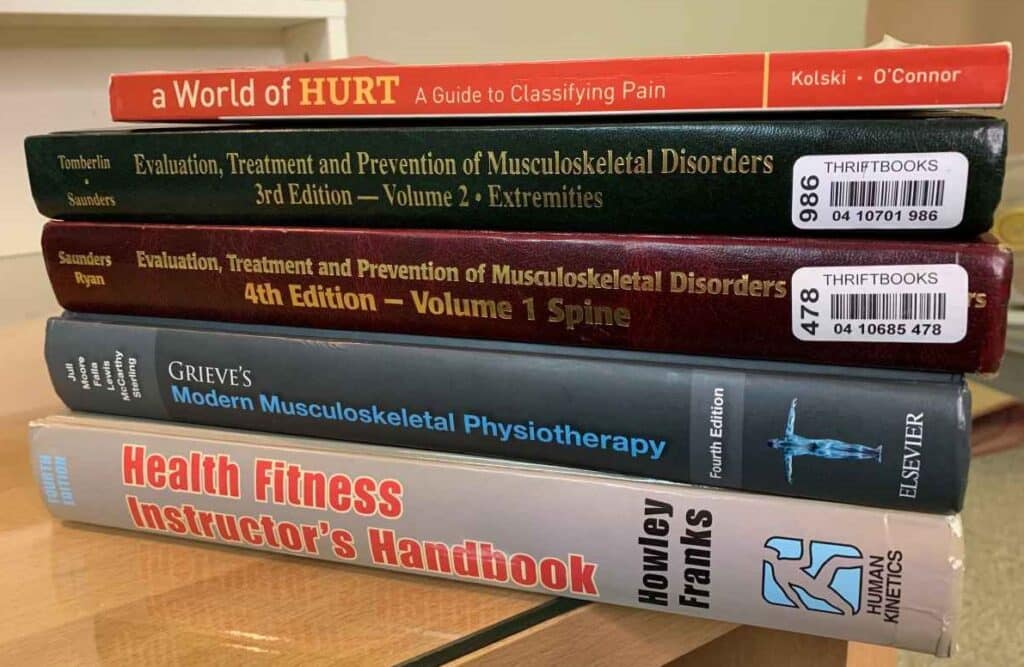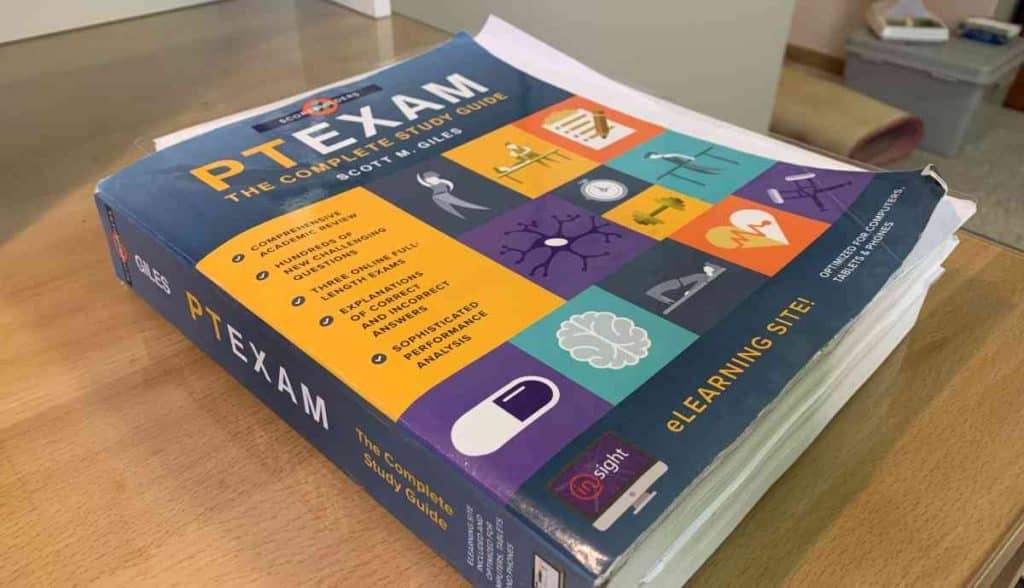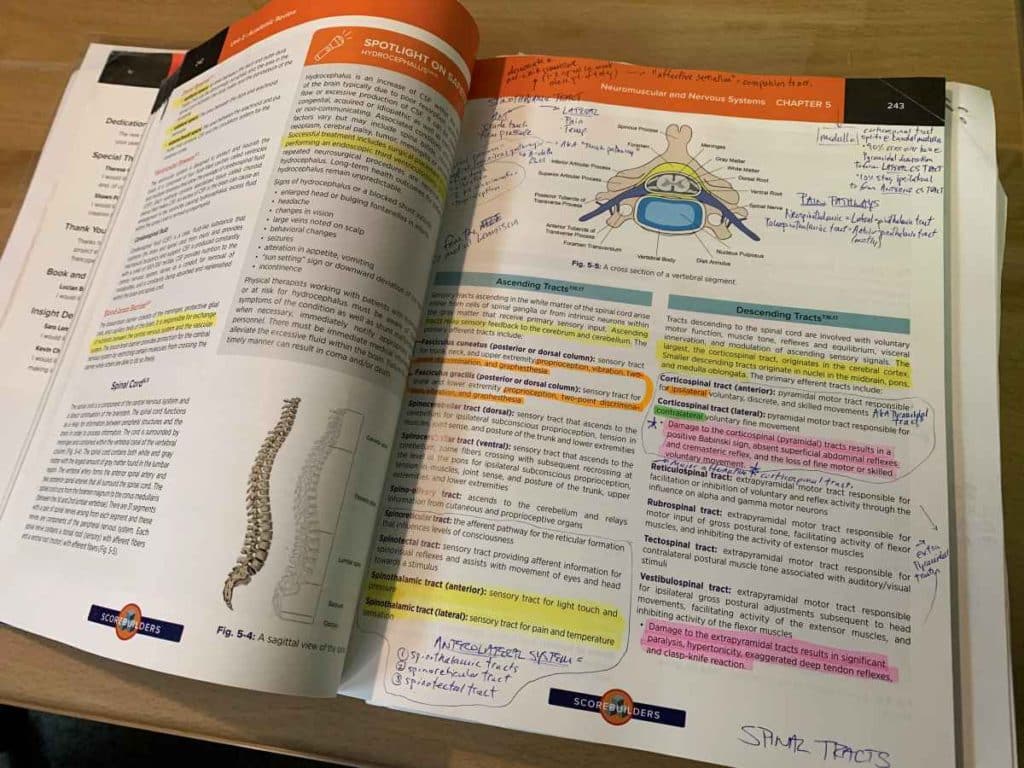Purchasing textbooks in PT school is an interesting thing. Some students may wind up purchasing every single textbook “required” throughout school while other students may not purchase a single one. Many students will fall somewhere between on either end of these extremes.
It is indeed possible to do just fine in PT school without purchasing any textbooks, (which is what I did). BUT, life can certainly be easier if you purchase the right ones. The key, if you plan on purchasing textbooks is to get the most out of them and maximize your return on investment. After all, these things aren’t cheap.
The quick answer as to what the most beneficial academic books are for PT school
The most beneficial textbooks as a physical therapy student are books that can be a resource for multiple classes rather than a single class AND can be a valuable reference once you begin professional practice. Therefore, if you could only afford three books, a wise choice would be:
- An NPTE study guide book (used version for duration of program)
- Grant’s Atlas of Anatomy
- Trail Guide to the Human Body
You may not necessarily need textbooks in order to get by in PT school, but there are indeed some that can be extremely beneficial for a variety of your physical therapy courses AND can be a valuable, go-to reference over and over again once you enter clinical practice.
These types of books are the books you should consider purchasing, if need be. There are a few key books that can fit this criteria quite well. For the sake of money, this article is looking at the top three books. Meaning, if there were only three books you could ever purchase for PT school, I would select the three that I mentioned above.
I will discuss in further detail as to how beneficial each textbook can be for PT courses as well as once you enter clinical practice, so be sure to keep on reading!
Article overview
- Why it’s a good idea to know which books will be the most beneficial for you
- Criteria for determining how beneficial a PT textbook will be for you
- Breakdown of each textbook and why it may be the right purchase for you
What about all sorts of other books?
Alright, so let’s keep in mind that there are indeed many other great books that PT students can (and perhaps should) consider acquiring. The whole premise of this article however is to help students to begin to think about how they can save money AND maximize their return on investment with these books.
In my years of PT school, I honestly didn’t use textbooks a ton, largely because I was oftentimes able to find amazing (and free) resources all over the internet, including YouTube, Wikipedia, and so on. I was never once in danger of low grades, so I just didn’t need the books. And if I did, I would rent them from the library or study with a friend who had a copy.
Courses such as Neuroanatomy have amazing, free online textbooks you can use, and if you want a free, online neuroanatomy textbook put together by the University of Texas, be sure to check out my article: The Best Free Resource for Neuroanatomy Courses in PT School.
Why it’s a good idea to know which books will be the most beneficial for you
The only real reason as to why students may try not to purchase textbooks is simply due to the cost. Sometimes a student truly doesn’t feel the need for a course textbook, but I would argue that most PT students would choose to get textbooks if costs simply weren’t an issue.
I’ve written an extensive article as to whether or not you really need to purchase textbooks while in PT school. To get some valuable insight on this topic, I’ve got an informative article that I’ve written for you to read: Do You Need to Buy Textbooks for PT School? What You Should Know.
Remember, always buy used textbooks. There is no need to purchase the very latest edition of a book. A previous edition will serve just fine for any of your curricular-based coursework.
The only exception: If you are planning on buying a board exam study guide review book (such as Scorebuilders or O’Sullivans), then you may want to consider buying a new version when the time comes for studying for the board exam. The reason being that a new version will provide you with practice examinations (which are extremely beneficial) whereas used versions won’t. You can still purchase these practice exams separately, however, if you would like.
That being said, I would consider buying a used board exam book (for dirt cheap, hopefully) at the start of your program. Then, consider buying a new version at the end of your program, or perhaps just buy the practice exams instead.
Criteria for determining how beneficial a PT textbook will be for you
If someone were to ask me what the most beneficial books are for PT students, I would base the criteria on the following factors:
- How likely is it to help with curricula in PT school, and not just for a single course, but for as many courses as possible.
- How likely is it to continue to be a beneficial resource when entering clinical practice
How many courses can a single textbook help you out with? The more the better!
Is it worth purchasing a specific textbook that will only be a beneficial resource for one or two of your courses within physical therapy school? Maybe. This is something you ultimately get to decide. My insight however, would be that it’s a lousy return on investment to purchase a book (if it’s expensive) that can really only be beneficial for one single course.
If need be, just try to rent the textbook for the semester, but when specifically considering PT coursework, if a textbook won’t be beneficial for at least a handful of classes, it may not be worth considering.
The bottom line: The greater the number of courses that one single book can help you out with while in school, the greater the return on investment for that particular book. If you can get the book for dirt cheap, for free or can rent it for the semester, then go for it. Otherwise, it may not be worth it. There’s plenty of amazing, free resources online that can help you out instead.
How beneficial will the textbook be as a continual reference once you’re in clinical practice
The fact is, most students are looking to practice within one single area of physical therapy when they obtain their professional license. Therefore, one must really ask themselves if it’s worth purchasing a textbook that they will have no need for once they enter clinical practice.
Any purchase of a textbook should be viewed through the lens of not just how beneficial it will be while in school, but after school as well. It’s just not worth purchasing a $150 textbook on woundcare management when you know that you will be going into a clinical specialty that never treats wounds.
Therefore, if you plan on going into a specific area of practice once you graduate, you may feel it beneficial to pick up the course textbook (used, hopefully) since it can be a valuable clinical resource down the road.
Yes, you can always sell your textbooks back, but for an absolute ripoff of a price. Again, in my other article, Do You Need to Buy Textbooks for PT School? What You Should Know, I’ve talked about other strategies to consider, such as renting textbooks for a semester if need be.
The bottom line: If you know the area of practice you’re looking to go into once you graduate, you can save yourself some money by foregoing purchasing any books you’ll need in PT school but will never use again once graduating. This doesn’t mean that you may not need these books during school, but rather that they simply serve no value in outright purchasing. If need be, rent the textbook from your institution or another company, or team up with a classmate and split the cost of buying a used version.
Why you should get a used NPTE study guide book at the start of PT school
Usefulness across all PT courses: 10/10
Usefulness as a resource once you enter clinical practice: 6/10
If there were only one single book to get while in PT school (this is purely a hypothetical situation), it would be an NPTE study guide book, such as the Scorebuilders or O’Sullivan’s book.
But wait, I just started PT school! Why would I pick up a book that I’m supposed to use at the end of school?! I hear you asking this question already.
Usefulness as you go through physical therapy school
Here’s the deal: An NPTE study guide book contains the critical information for every course that you take in PT school. The book is designed to be a massive review of nearly three-years of coursework, and so while it may not have the rather fine details you learn within each course, it will have all the big, pertinent information that you’ll cover in each of these classes.
What this means is you can save yourself not only a TON of time trying to always hunt down information on the web or in other textbooks, but you ALSO can rest assured that the information within it is accurate and inline with what the FSBPT wants you to know, along with your school as well.
One book. Nearly every single course. Trustworthy information. Enough said.
I WISH I would have done this when I entered PT school, since it would have helped me not only get a few extra marks on exams and quizzes, but it also would have saved me TONS of time that I lost when having to scour the internet for the information I needed or having to verify that the information I gathered was accurate and/or inline with what my courses were teaching me.
Remember: Get a used book for the duration of your program, and consider picking up a brand new version at the end of your program if you want the included practice exams
As mentioned earlier, get your hands on a used review book while you make your way through your PT program. They are usually rather inexpensive and you DON’T need the most up-to-date version while you go through school.
Once it comes time to studying for the NPTE, a new version is worth the investment, since you’ll be able to get the included practice exams that often come with a new study book. I would encourage everyone to pick up a new book at this point – the investment into having more practice exams and better chances of passing the NPTE on your first attempt is well worth the few extra bucks you’ll spend on a new book.
Usefulness as you graduate and enter clinical practice
Believe it or not, this book can come in handy once you enter clinical practice. After all, once you’ve graduated, the real learning now begins. While this book won’t necessarily be an amazing go-to resource, it can still be useful for quickly referencing and brushing up on tons of techniques and information that you may need to use within clinical practice.
Looking up lab values, special tests, pathologies, treatment techniques and so on can easily be done in one of these books, and while it may not provide the high-level of detail that you need, it will oftentimes provide enough.
Why you should consider Grant’s Atlas of Anatomy (or any other anatomy textbook)
Usefulness across all PT courses: 6/10
Usefulness as a resource once you enter clinical practice: 8/10
An anatomy textbook will be a bit of an investment, as these books typically cost more than the average book, since they are quite large books. The good news is that there is never a reason to purchase a brand new anatomy textbook; the anatomy of the human body hasn’t changed in a few thousand years, most likely. As long as the book has pictures with labels of the anatomical structures you need to learn, you’ll be just fine.
If the cost is still an issue for you, you may consider other amazing resources such as 3D4’s Complete Anatomy or Essential Anatomy 5, which you can use on your iPhone, iPad or desktop. These apps are absolutely amazing and just a fraction of the price of a hard copy anatomy textbook.
But, if you can swing it, a hard copy anatomy book is always nice to have for both school and for keeping on hand in the clinic.
Usefulness as you graduate and enter clinical practice
There are two key ways in which an anatomy textbook comes in handy when you’re practicing in the clinic:
The first is that it’s of course a continual reference for you. You will be presented with dozens and dozens of situations every year in which having a quick anatomical reference will help you out. No physical therapist is good enough to never have to reference an anatomical textbook from time to time. As the old saying goes: Only fools know everything.
The second way in which this textbook will come in handy is for showing your patients the specific anatomical structures you may need to educate them on, such as showing which joint or structure is painful, dysfunctional and so on. Patients often like having a visual understanding of what’s going on with them and/or what exactly it is that you’re trying to treat.
I find myself these days often using my Complete Anatomy app to show my patients such information, but a hard copy textbook is always worth having on hand.
Trail Guide for the Body
Usefulness across all PT courses: 5/10
Usefulness as a resource once you enter clinical practice: 5/10*
*This is under the assumption that you will enter a practice designation (such as orthopedics) that requires a heavy manual or hands-on treatment component to the population whom you treat.
A substantial portion of PT school (and your clinical practice thereafter) will consist of your anatomical knowledge and then drawing upon that knowledge to effectively locate, palpate and identify different structures of the human body. If you can’t effectively do this, many of your labs in PT school can be pretty rough, and your ability to provide targeted, hands-on treatment techniques can suffer (both for laboratory purposes and when in clinical practice).
Having the knowledge of anatomical features and structures is one thing, being able to effectively (and confidently) find or palpate them is another. (I’ve found this out the hard way a few times throughout PT school and within the clinic.)
Trail Guide for the Body can therefore prove to be quite a beneficial resource for helping students for a number of their PT courses as well as continuing to enhance their hands-on skills as a new graduate (provided they plan on entering a field that requires frequent hands-on palpation assessments and treatment techniques).
Is it absolutely necessary? Not entirely, but it can no doubt be quite beneficial, especially for those who are visual learners (such as myself). Investment-wise, it makes good sense to pick up a copy since it isn’t an overly expensive book and can serve you well across multiple courses and thereafter when in clinical practice.
Concluding remarks
The decision for students as to whether or not purchase textbooks while in PT school is largely (if not exclusively) due to financial considerations. If you can get a course textbook for free, dirt-cheap or rent it for a semester, then it can indeed be worth it.
But, oftentimes it’s helpful to purchase only the books that will help in a number of your PT classes AND/OR be a beneficial go-to resource once entering clinical practice. It doesn’t make much sense to purchase a textbook that will only be useful for one single class.
It also doesn’t make much sense to purchase a textbook that you know you will never use again after school is over with. And it certainly doesn’t make any sense to purchase a book that only helps for a single class while also being a book you will never open again after you graduate.
The key (assuming that money is tight and that you’re trying to save as much of it as possible) is to always try and purchase the books that will be helpful for a variety of your PT classes AND be beneficial once you enter clinical practice.
As always, it’s all up to you in the end, and you’re the best one to make the decisions on your books since you know your situation better than anyone else. Hopefully the ideas presented within this article can help further guide you towards knowing how to make a better purchase and potential investment into any of the books you’re thinking of purchasing for PT school.

Hi! I’m Jim Wittstrom, PT, DPT, CSCS, Pn1.
I am a physical therapist who is passionate about all things pertaining to strength & conditioning, human movement, injury prevention and rehabilitation. I created StrengthResurgence.com in order to help others become stronger and healthier. I also love helping aspiring students and therapists fulfill their dreams of becoming successful in school and within their clinical PT practice. Thanks for checking out my site!





